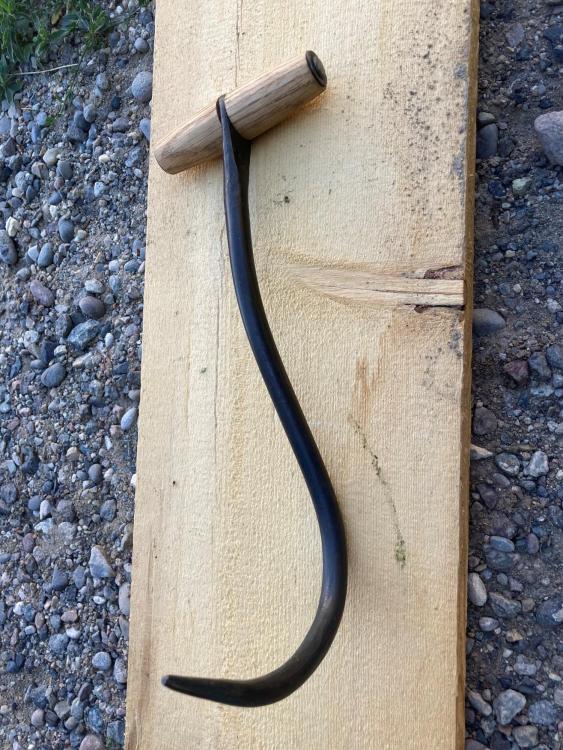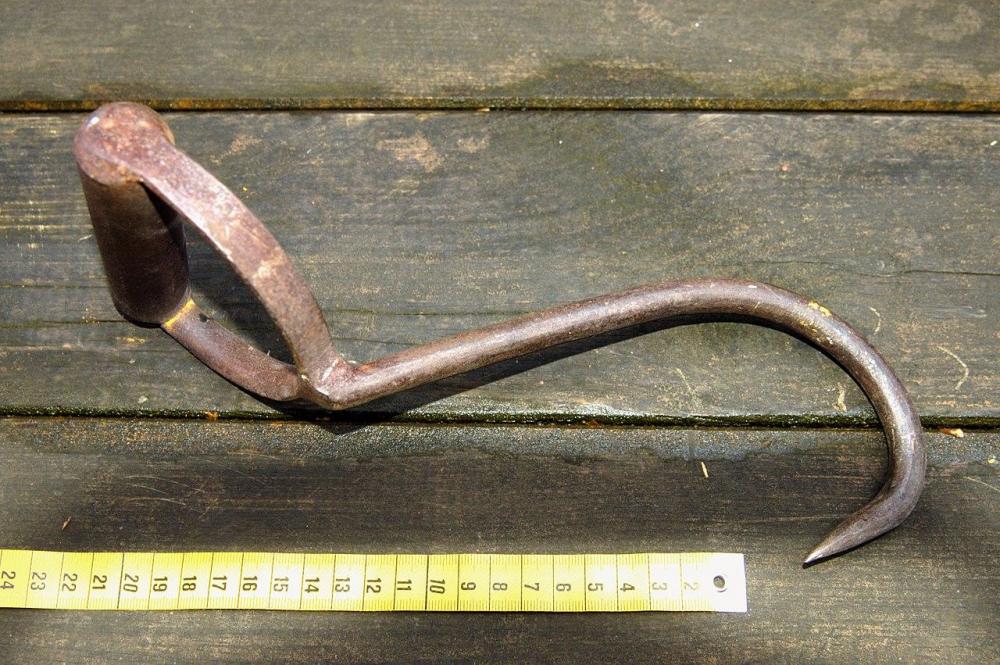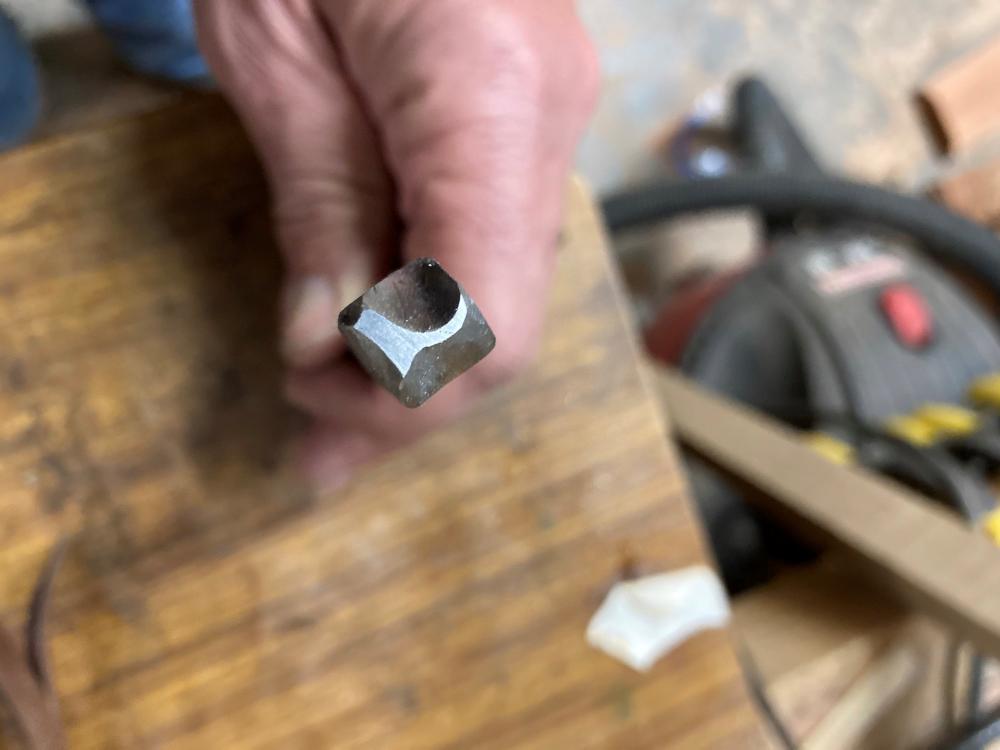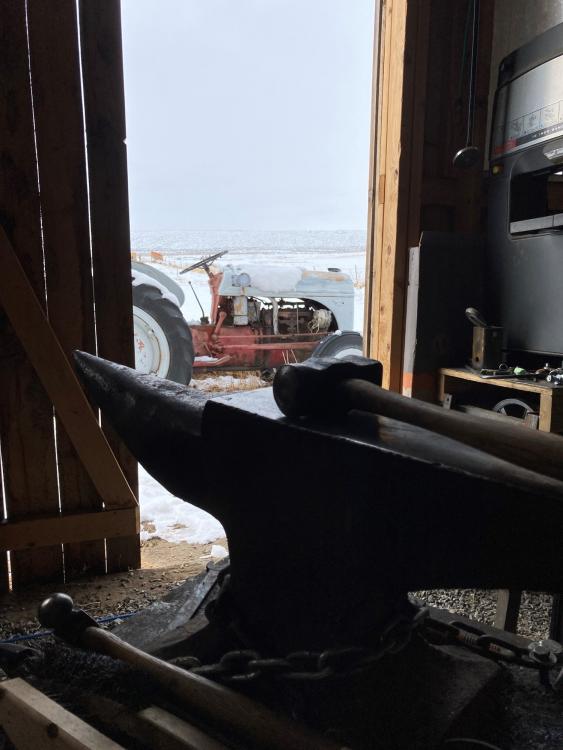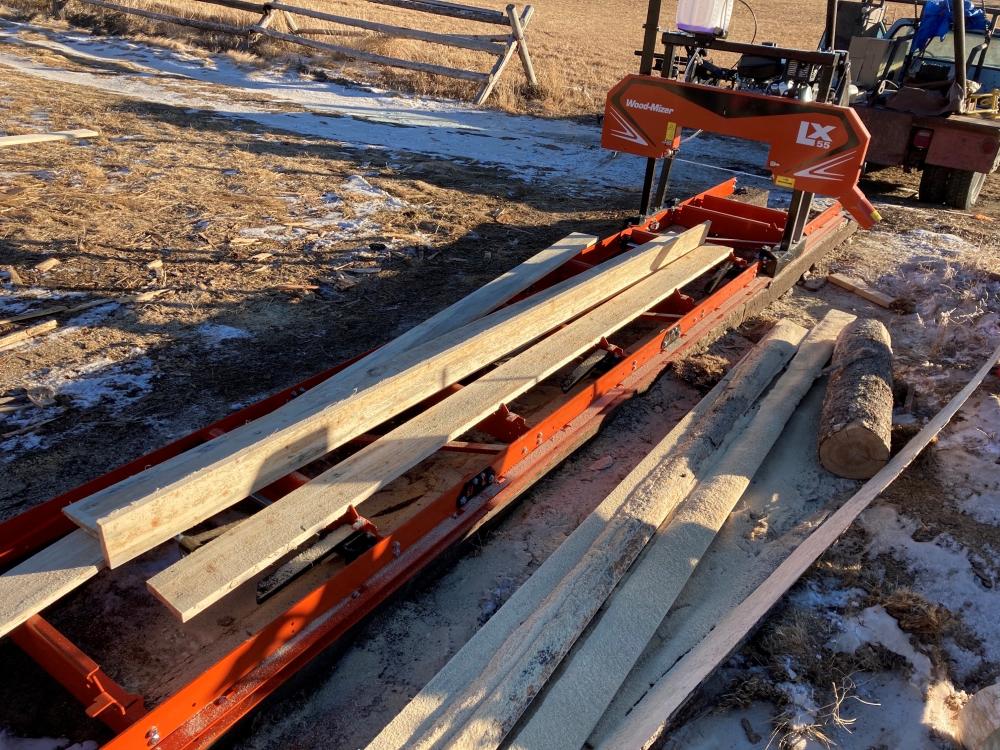-
Posts
124 -
Joined
-
Last visited
Content Type
Profiles
Forums
Articles
Gallery
Downloads
Events
Everything posted by gmbobnick
-
Looking for input on design and forging of a bale or hay hook. Its a pretty simple tool that has many uses for handling heavy bulky items such as logs or hay bales, of materials you can sink a hook into. There are a few geometric nuances that affect its effectiveness, such as pitch of the hook, shaft length, weight/diameter of shaft, point taper etc. What I am mainly interested in though, is how to forge the thing with a design that both works well yet is not overdone and time-consuming to forge. . I made one that works ok, but I don’t like the feel of the shaft between my fingers, even though I flattened it to about 4 or 5 sixteenths. I need to improve the wood handle shape and fit some, so this is just a trial. Here it is. Longshoremen used this kind of tool for years and have no doubt found a design that is effective. It has a different style of handle. Here is an example I found on the internet: I am going to try it, or with a handle something like it, but I am still awkward with my forge welding. I want to sell these tools, and therefore need to have an efficient process to fabricate them. I want to present them as traditional forged work, and so don’t want to arc weld the two pieces together. I suppose I could split the shaft bar and splay it, but I’d have to start with a fairly thick, heavy shaft I think, which adds weight. Maybe that is ok, but I don't think weight is needed or desirable My goals are: 1. Traditional construction 2. Comfort 3. Efficient use of material 4. Efficient fabrication Anyway, before I spend hours and hours trying to get to a viable way of making these with my goals in mind, I’d like some input from experienced smiths as to how they would tackle it. If I need to up my forge welding skills then so be it, if that is the best way. Maybe there is a better design than what I showed, and any input on that would be helpful as well.
-
Frosty, your replies on drilling was hugely informative and clearly comes from a lot of experience. Thanks for taking the time to write that all out.
-
I make my own wood finish for things that will see weather by using various combinations of boiled linseed oil, turpentine, soil-based stain and spar varnish. Generally equal parts of each is a reasonable starting point. Often for the first coat I omit the spar varnish and up the turpentine a bit so the oil penetrates better, and then add spar varnish in on the second coat. An interesting finish is to paint on iron acetate made from a solution of dissolved steel wool in vinegar. High tannin woods like oak turn black, deeply. Then you can oil or wax as you see fit. I am intrigued by the possibilities of blending pine tar into some of the formulas that I use. No recommendations yet on that. One other suggestion is to leave the wood, especially hardwood, somewhat rougher...say 120 grit. Then put the first coat on to allow the oil and solvent to penetrate more deeply. You can then sand it to the desired final smoothness when it is semi-dry. This helps fill some of the pores for an even more durable surface. Final coat with formula using spar varnish.
-
Took at stab at adapting this idea to a "pronghorn" finial, more or less following the suggestions made in this post. Some room for improvement, but it'll work!
-
Its threaded onto the 5/16" tang. Next time I will drill and tap after it is completely formed...its a pain otherwise. I had the notion that the little scroll would butt up against the end of the tang and make some tension to help hold it in place. I suppose a dab of CA glue works...just not very traditional.
-
After making several versions of a simple old hoof pick for promotional purposes, I think I finally have something pretty close. I wanted something that represents the aesthetics of furniture I make. So, it should have a rustic-western look, feature some wood (handle of course), have a little forged hardware (pommel), black metal finish, and can be made in about an hour or less. I think this is close. I need to work on improving efficiency of making the pommel a bit as this is the most time consuming part.
-

Faster Better Cheaper...Questions
gmbobnick replied to gmbobnick's topic in The Business Side of Blacksmithing
I better correct something. Latent skills might not be the best term. Latent talents is probably more accurate. Dad was a skilled machinist and grandpa was a skilled carpenter in the old sense of the term...everything from carved ladles to mine structures. I am pretty sure they wouldnt have accomplished what they did without talent. -

Faster Better Cheaper...Questions
gmbobnick replied to gmbobnick's topic in The Business Side of Blacksmithing
Your responses are very enlightening, and have provided a lot to think about (like I need that), and has been humbling for me as well (I really do need that). Just to focus things a bit. My essential goal is to immerse myself in a craft (now that I can) while being personally accountable for my time. I want to develop what I think are latent skills. Skills that I see in my ancestry. I delight to see them come to light in the workshop. My scrap pile still grows, but I am starting to see some progress and increasingly feel better about what I am able to accomplish. Naturally I want to do more, but I think its important for the time spent to be productive. God knows where this endeavor will go. But unless He shows otherwise, I am not designing it to become anything more than one man doing the best he can, while he is still physically and mentally able, to leave something valued and beautiful behind for others to use and enjoy. So here is where I am at: I have chosen furniture as my platform…which sounds eerily like a mesa or butte. Thank you Rockstar for that useful metaphor. I have chosen western styled, rustic furniture as what I suppose would be a genre….not wanting to sound too artistic. Hand forged hardware, fittings, purposed-functional features would be a key element. The question is, how do I efficiently and effectively launch this endeavor? This is what I am thinking… First. give the business a western identity or branding, which for me is represented of course by a Pronghorn Antelope. Second, pick a target group of customers to start with. I am looking at “horse people”, or what could be called the equine industry. Not that this would encompass all potential customers...just a starting place. Make a line of somethings that this kind of customer would be interested in. Somethings like bridle racks, hay hooks, hoof picks, saddle racks. None of this is custom made, but it will be well made or I wont sell it. It gives them a chance to buy something special, an easy sale, and introduces my business. Then maybe an opportunity to introduce hand crafted furniture that would suit their idea (and mine) of personal style. I think furniture…coffee tables, special cabinets, kitchen tables, beds etc…elevate the potential value and beauty of things made to where I would it like it in pursuit of my goal. That is my dream and the path I hope to follow. The feedback and input y’all have provided is an encouragement and helps fill some gaps in my thinking. -

Faster Better Cheaper...Questions
gmbobnick replied to gmbobnick's topic in The Business Side of Blacksmithing
For all the writing I do, at times I still fail to see things the way my audience does, and it gets me in trouble. I should explain things more thoroughly before making potentially inflammatory statements, and for not doing that I do apologize. I did not mean to set Frosty off. I think of custom work as work done according to the specifications of an individual. Made to order if you will. I have known some that do custom work, and with a few exceptions, they are not friendly people. Some might even be miserable. Customer burn-out is the malady. Those few exceptions are extraordinary people. One is my best friend, but he has a lot of best friends. I think to be exceptional at custom work, it takes being a master at the craft first and foremost. Then it takes an extremely attentive listener. Diplomacy is another key trait. There are probably other virtues required as well. I know enough about myself to know it’s not me. So what will I make? Furniture. I have had enough interest in what I make that I think I can sell hand-crafted furniture, but not custom furniture. I’ll leave it at that. Thanks everybody for the lively and educational conversation. -

Faster Better Cheaper...Questions
gmbobnick replied to gmbobnick's topic in The Business Side of Blacksmithing
You are right on that, and it has not escaped my attention. Jackson is about 2.5 hours from my...ahem...forge, with a few pretty darn nice fishing holes in between. Pronghorn antelope are about the fastest land animal in North America. I hope potential customers don't infer that they will get forged products speedily. One thing I am trying to avoid is custom work. I don't deal well with sniveling. -

Faster Better Cheaper...Questions
gmbobnick replied to gmbobnick's topic in The Business Side of Blacksmithing
I assumed a zither is a bird. Why would anybody pluck a zither except to prepare it for supper? A mental image formed of a cleanly plucked zither in a roasting pan, nicely browned. I got hungry. I was disappointed to find that according to Wikipedia a zither is a musical instrument. However, I do have some pronghorn antelope in the frig for lunch. It doesn’t look anything like a pronghorn antelope. -

Faster Better Cheaper...Questions
gmbobnick replied to gmbobnick's topic in The Business Side of Blacksmithing
As a footnote… While a blacksmithing business named “Larry” could possibly survive, I admit that having a somewhat pertinent name cannot hurt even if its not the linchpin for the business marketing plan. A memorable name helps for referrals. I think Pronghorn Forge & Furniture works for that because: It creates a mental image…great for memory The imagery relates succinctly to a touchmark that is permanently on the thing made It connotes a craft and not a retail business. I could say blacksmithing instead of forge, but forge has 8 fewer letters....plus it flows nicely with the word pronghorn The craft (forge work) is specially connected with furniture…the stuff I really want to make -

Faster Better Cheaper...Questions
gmbobnick replied to gmbobnick's topic in The Business Side of Blacksmithing
“Forge” is unquestionably common in blacksmithing business names. That term does not help focus any Google search. Nor does “Pronghorn” or “Furniture”. If my marketing plan relies on algorithm strategies or internet search engines, then “Pronghorn Forge & Furniture” is certainly doomed. However, here is a plan that is upside down in a big-data way of thinking. Rather than starting with the population of the world and working in, how about starting with a few perfect customers and working out? I am thinking of the emotional purchase that Rockstar mentioned. Somebody who would actually buy a damascus wire stripper truly won’t or can’t use Google to find it. They may not even think having one would be cool until they see it. Then they want it. This is the person who will buy what I want to make, for the price that makes it worth my while…and delights the customer. The plan relies on them doing the advertising for me. So where to begin? How about by just making something or a few somethings that are emotionally appealing. Something folks in a certain group use frequently. Something that lasts a long time. Something made by hand…even forged. Something that looks super cool. Something unique and special. Something that reflects their personnel tastes, and even the quality of what they do and how they do it. Something made in the USA. Something that will cost more than the common mass produced thing. Knives certainly come to mind as a thing that fits these criteria. But these same criteria can apply to a jillion other things too, like Damascus wire strippers, and the groups of folks that might use them, like professional electricians. Just need to get it in front of the right group of people that it will appeal to...and there are many ways to do that. Shucks, it could even mean just giving the something to the exact right person as a gift. Then what the business does trumps what the business is named. I could call the business “Larry” and it might not matter. I believe this business can evolve from there on the principle of quality and by referral. Maybe I am completely wrong. It’s a good thing I am not depending on this business. I’m gonna have some fun seeing if this works anyway. -

Faster Better Cheaper...Questions
gmbobnick replied to gmbobnick's topic in The Business Side of Blacksmithing
-

Faster Better Cheaper...Questions
gmbobnick replied to gmbobnick's topic in The Business Side of Blacksmithing
I guess they must find some nourishment in the stems...enough to make a few turds anyway. -

Faster Better Cheaper...Questions
gmbobnick replied to gmbobnick's topic in The Business Side of Blacksmithing
Pronghorn antelope like to wander down the fence line about 30 feet from my shop. Actually, I could call it elkhorn too. A couple weeks ago I was standing in the shop door waiting for a piece of steel to heat up and saw this out in my hay field. Thanks for the idea GeorgeNM! -

Faster Better Cheaper...Questions
gmbobnick replied to gmbobnick's topic in The Business Side of Blacksmithing
I continue to be impressed by the willingness of the membership here to dedicate their time and provide thoughtful answers to questions. Thank you all for the time and thought you have responded with here. It helps to have others to bounce ideas off. Fortunately, I am not depending on the business to survive. Its more of a challenge than anything. Yeah I do over-think things. But I love planning. Been that way for 60 years and likely won’t stop. But stress? Not at all. I am enjoying the creative outlet. Even drew up my own logo…what do you think? -
It seems like every business model needs to address at least the 3 principles of faster better cheaper. But perhaps all three do not necessarily need to be treated equally. The emphasis given to each defines the business. In other words, a business focused mainly on one of these three principles will be known accordingly. So, some questions. Do I want my business known for its short response time, or high quality, or low cost? Or is it some compromise? Does it change in time? If indeed a compromise for equality, then isn’t there a market consequence? Maybe the business will not stand out, and may not even survive. But if a business is to stand out, then shouldn’t it be sold out to one of the three principles? With regard to blacksmithing business, shouldn’t the leading principle be quality? Modern industry can beat a blacksmithing business silly when it comes to faster and cheaper. But quality…maybe not always. As I venture into business with my forging and woodworking operations, I am trying to find those products that are attractive to prospective customers because of the quality. Things that are readily distinguishable from what is typically found in the store in terms of quality. Even before getting the stock hot, selecting a section that is thicker/heavier (to a point) than what is available in the marketplace could start the quality wheel rolling. Then adding a few quality flourishes…nice finish, clean lines, thoughtful design etc. goes further down that road. Finally, good tool work…not necessarily perfect…just the signs of purposeful, appropriate, efficient, consistent tool work. But maybe it is not good taking quality to an extreme…at least initially. Excessive detail, complicated design, and precise joinery may be appreciated by certain few, but the business needs to appeal to a broader set of customers to move product and be viable. I don’t have that level of skill just getting started anyway. So speed and low cost cannot be abandoned completely. Maybe speed and inexpensiveness can be diminished in time as clientele grows, but it seems this is an evolutionary process…does that work? Since this is just the beginnings of what may be an endeavor that will carry me through post-professional career years (aka retirement), I cant speak from the depth of experience. I am interested to hear what those of you with lots of experience in the business of blacksmithing think, how your business has changed and grown with respect to the 3 principles, any big regrets, and any gems you might be willing to share.
-

How do you develop a useful scrap pile ?
gmbobnick replied to Glenn's topic in Blacksmithing, General Discussion
Regarding Glenn's questions in the OP... Being intentional about what to look for in scrap is what makes the pile useful for me. I try not to get distracted by possibilities, which is hard to do because that quells imagination, and goes against one of the most attractive things about blacksmithing. Things that are possible can brew a LONG time...which means a huge pile of junk. It makes the wife unhappy, and snakes hide in there. Instead, I look for steel that will serve a purpose. Basically things that I know can be heat treated to something better than mild steel mainly for use as tooling. Sucker rod, axles, drive shafts, all manner of springs etc. I wont turn my nose up at mild steel if its in a shape close to what I would buy for project materials, or if I see a purpose as a jig. Otherwise, I seldom look to the scrap pile for project material...feeling that my random experimentation days are largely over. I try and focus my forge time on making useful/marketable stuff according to design using shapes that are as close to the final product dimensions as possible. The design itself is where I concentrate my creativity. My favorite source is the scrap bin at a Ag Equipment repair shop. -
As a kid, now over 40 years ago, I found a couple 2x8 hardwood planks that I think were used as a ramp to drive a piece of equipment onto a trailer. After some study I determined they were hornbeam. Heavy...and harder than the back of my head. I have found it to be most excellent handle material. There is a European variety. Possibly similar use there, or perhaps as trailer decking nowadays.
-

What did you do in the shop today?
gmbobnick replied to Mark Ling's topic in Blacksmithing, General Discussion
God delivered free quenchant here in Wyoming today. What better reason to go out to the forge and tinker? -
Howdy Blackcloud. I live about an hour from the south end of the Bighorns. Maybe not far from you? Praying for your full recovery. Wish I could post some pictures of knives I've made. Maybe some day. For now I just admire those whose skills far surpass mine.
-

What did you do in the shop today?
gmbobnick replied to Mark Ling's topic in Blacksmithing, General Discussion
I am at peace with the fact that my area has little in the way of hardwood for furniture. We have various conifers (softwood) in the mountains that provide gorgeous wood, have great machining properties, stain and finish wonderfully, and are entirely useful for furniture. Plus, I love the excuse to go up in the mountains and cut logs. -

What did you do in the shop today?
gmbobnick replied to Mark Ling's topic in Blacksmithing, General Discussion
At first blush it wouldn’t seem to have much to do with blacksmithing, but I finally received my sawmill, got it assembled, and it is now in production! A happy day…and the new ability to make unique lumber for wooden objects upon which I can mount various forged handles, hinges, hasps, brackets etc. -

Loaning my 3 phase belt grinder
gmbobnick replied to ede's topic in The Business Side of Blacksmithing
I appreciate this question Ede. I think the answer is highly dependent on how you roll. Here is my spin. Everything we have amounts to nothing at our last breath anyway. In the meantime, I’d look upon this as an investment in a promising friendship and let the deal go down with a firm handshake. If it goes bad, then chalk it up to becoming a better judge of character. If it goes well, then who knows how rich the blessings will grow from a little trust. I think the more we lean on faith than the material things that we accumulate, the more wonderful and meaningful life becomes. I am pretty sure that Charles Dickens would agree.

